The KWL chart, a widely used educational tool, is designed to enhance learning by helping students actively engage with new topics, organize information, and monitor their own comprehension. The acronym KWL stands for "What I Know," "What I Want to know," and "What I Learned." This simple but effective graphic organizer encourages students to reflect on their prior knowledge, set learning goals, and assess their understanding as they progress through a lesson or unit.
Part 1. What is KWL Chart?
A KWL chart is a graphic organizer or chart used in education to help students organize information before, during, and after learning about a topic. The acronym "KWL" stands for:

K - Know: This section is where students list what they already know about the topic before starting their study.
W - Want to know: In this section, students write down questions or things they want to learn about the topic.
L - Learned: After the learning activity or lesson, students complete the "Learned" section by summarizing the key points or information they have gained from their exploration.
The KWL chart is a versatile tool that can be adapted for various subjects and grade levels. It encourages active engagement, critical thinking, and reflection in the learning process. Teachers often use it as a formative assessment tool to gauge students' understanding and tailor their instruction accordingly.
Part 2. Understanding the Components of a KWL Chart
A KWL chart is a graphic organizer used in education to help students organize and reflect upon their learning. The chart typically consists of three main sections:
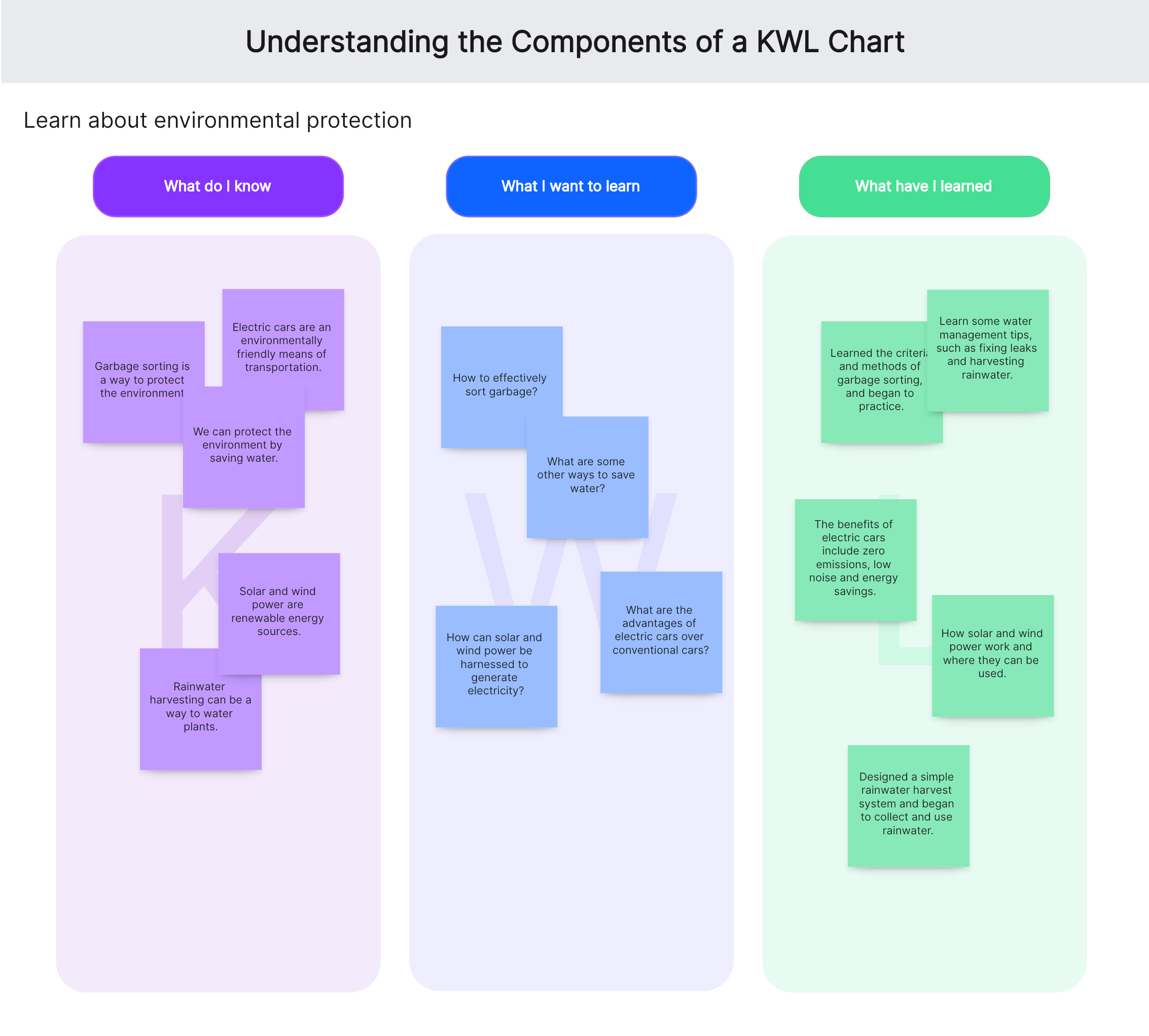
What I Know (K):
The first section of a KWL chart prompts students to list what they already know about a particular topic. This taps into their prior knowledge and experiences, providing a foundation upon which new information can be built.
Encourages students to brainstorm and recall any relevant facts, concepts, or personal experiences related to the topic.
What I Want to Know (W):
The second section invites students to express their curiosity and identify questions they have about the topic. This step helps them set specific learning goals and guides the direction of their inquiry.
Encourages the formulation of questions, promoting critical thinking and fostering a sense of ownership over the learning process.
What I Learned (L):
The final section is completed after the learning experience. Students summarize and document the information they gained, providing a tangible record of their newly acquired knowledge.
This section reinforces the idea of learning as an ongoing process, allowing students to reflect on their progress and adjust their understanding as needed.
Part 3. Benefits of Using KWL Charts
Using KWL charts in the classroom offers several benefits for both teachers and students. Here are some of the advantages:
- Activating Prior Knowledge: The "Know" section of the KWL chart helps students recall and activate their existing knowledge about a topic. This serves as a foundation for new learning and allows teachers to build upon what students already know.
- Setting Learning Goals: The "Want to know" section encourages students to generate questions and set learning goals. This helps to focus their attention on specific aspects of the topic, fostering a sense of curiosity and direction in their learning.
- Guiding Inquiry: KWL charts guide students through the inquiry process by encouraging them to seek answers to their questions. This promotes independent research and investigation skills.
- Organizing Information: The visual organization of information in the chart helps students see the relationship between what they knew initially, what they wanted to know, and what they have learned. This visual representation aids in comprehension and retention.
- Formative Assessment: Teachers can use the KWL chart as a formative assessment tool to gauge students' understanding throughout the learning process. By reviewing the "Learned" section, teachers can identify areas where students may need additional support or clarification.
- Encouraging Reflection: Completing the "Learned" section requires students to reflect on the new information they have acquired. This reflective practice helps reinforce learning and encourages metacognition.
- Differentiated Instruction: KWL charts can be adapted to accommodate different learning styles and levels. Students can use words, drawings, or a combination of both to express their ideas and understanding.
Overall, KWL charts provide a structured and visually appealing way to support effective teaching and learning strategies in the classroom.
Part 4. How to Use KWL Chart?
Using K-W-L charts in the classroom involves a structured process to activate prior knowledge, guide inquiry, and facilitate reflection. Here's a step-by-step guide on how to effectively use K-W-L charts:
Step 1: Introduce the Topic
Introduce the Concept:
- Begin by introducing the topic to the students.
- Explain that you will be using a KWL chart to organize their thoughts and track their learning.
Step 2: Know - What They Know
Activate Prior Knowledge:
- In the "Know" section of the chart, ask students to list everything they already know about the topic.
- Encourage a brief discussion or sharing of ideas to build a collective understanding.
Step 3: Want - What They Want to Know
Generate Questions:
- In the "Want to know" section, prompt students to think about what they want to learn or any questions they have about the topic.
- Have them list these questions on the chart.
Step 4: Learn - What They Learned
Conduct Learning Activities:
- Facilitate learning activities such as readings, discussions, videos, or experiments related to the topic.
- After the activities, ask students to summarize what they learned in the "Learned" section of the chart.
Step 5: Reflect and Review
Reflect on Learning:
- Engage in a class discussion about the learning process.
- Ask students to reflect on how their understanding has changed and if any new questions have arisen.
- Conclude the activity by reviewing the KWL chart and highlighting the collective knowledge gained.
This streamlined approach condenses the typical KWL process into five essential steps, making it a quick and effective way to engage students in exploring a new topic or concept.
Part 5. Best KWL Chart Maker – Boardmix
Boardmix is your go-to solution for creating comprehensive KWL charts online. Our intuitive platform allows you to easily sketch out what you Know, Want to know, and have Learned in a visually engaging format. Unlike traditional chart makers, Boardmix offers a plethora of pre-designed templates that cater to various learning styles and subjects. Whether you're an educator planning your next lesson or a student preparing for an exam, Boardmix's KWL Chart Maker simplifies the process of organizing information and tracking learning progress. Start exploring our features today and experience the difference with Boardmix.
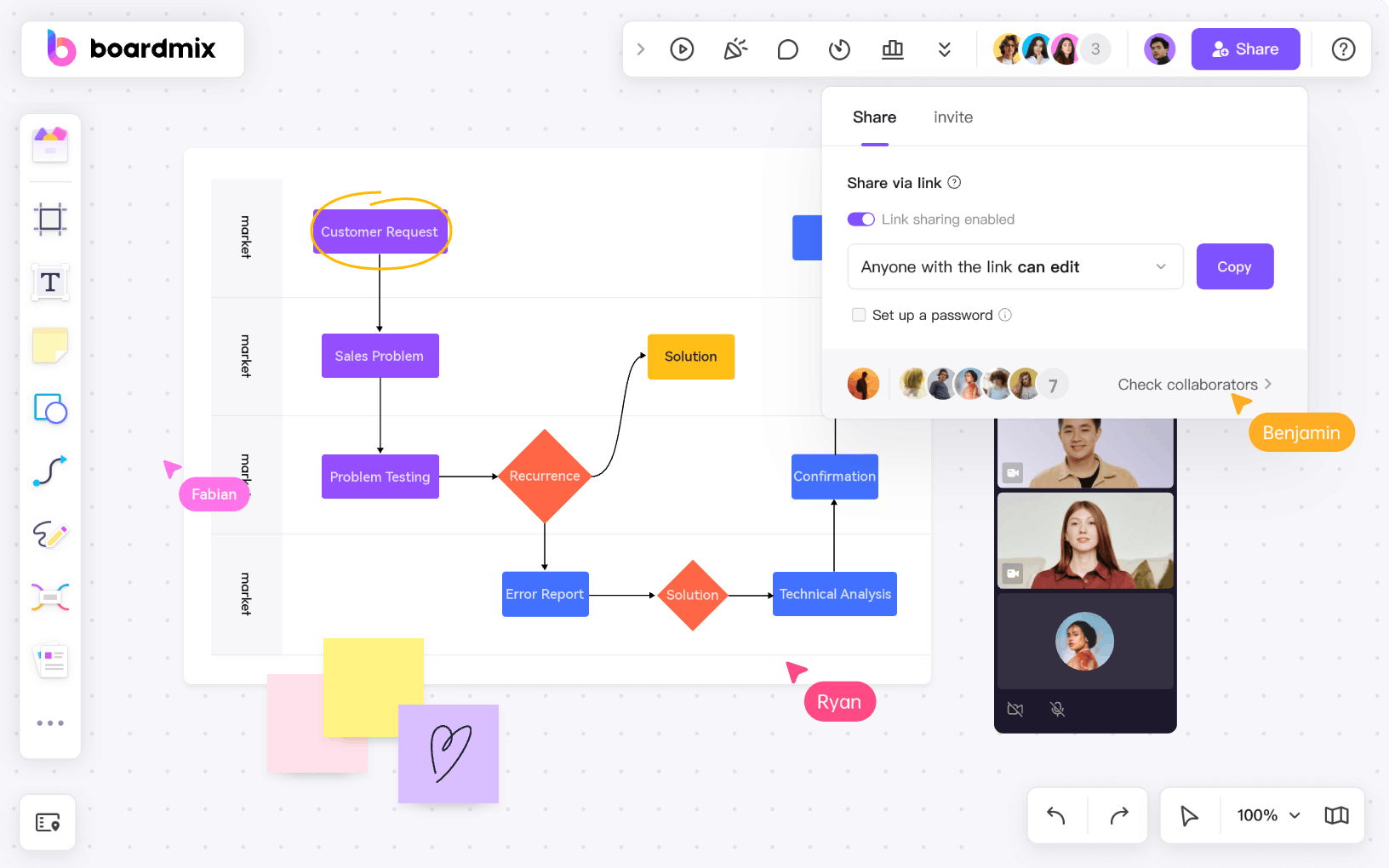
Key features of Boardmix:
- Interactive Whiteboard: Boardmix's interactive whiteboard provides a limitless canvas where you can brainstorm, sketch, and collaborate in real-time.
- Pre-designed Templates: With Boardmix, you have access to a wide range of pre-designed templates for various purposes like KWL charts, flowcharts, mind maps, and more.
- Easy Sharing: Boardmix allows you to easily share your creations with others via email or a unique link, facilitating seamless collaboration.
- Customizable Charts: With Boardmix's intuitive tools, you can customize your charts by adding text, changing colors, inserting shapes and much more.
- Real-Time Collaboration: Boardmix supports real-time collaboration allowing multiple users to work on the same chart simultaneously from different locations.
Creating a KWL chart with Boardmix is a straightforward process. Here's a step-by-step guide:
Step 1. Log in to your Boardmix account. If you don't have one, sign up for free.

Step 2. Once logged in, navigate to the 'Templates' section and select the 'KWL Chart' template.
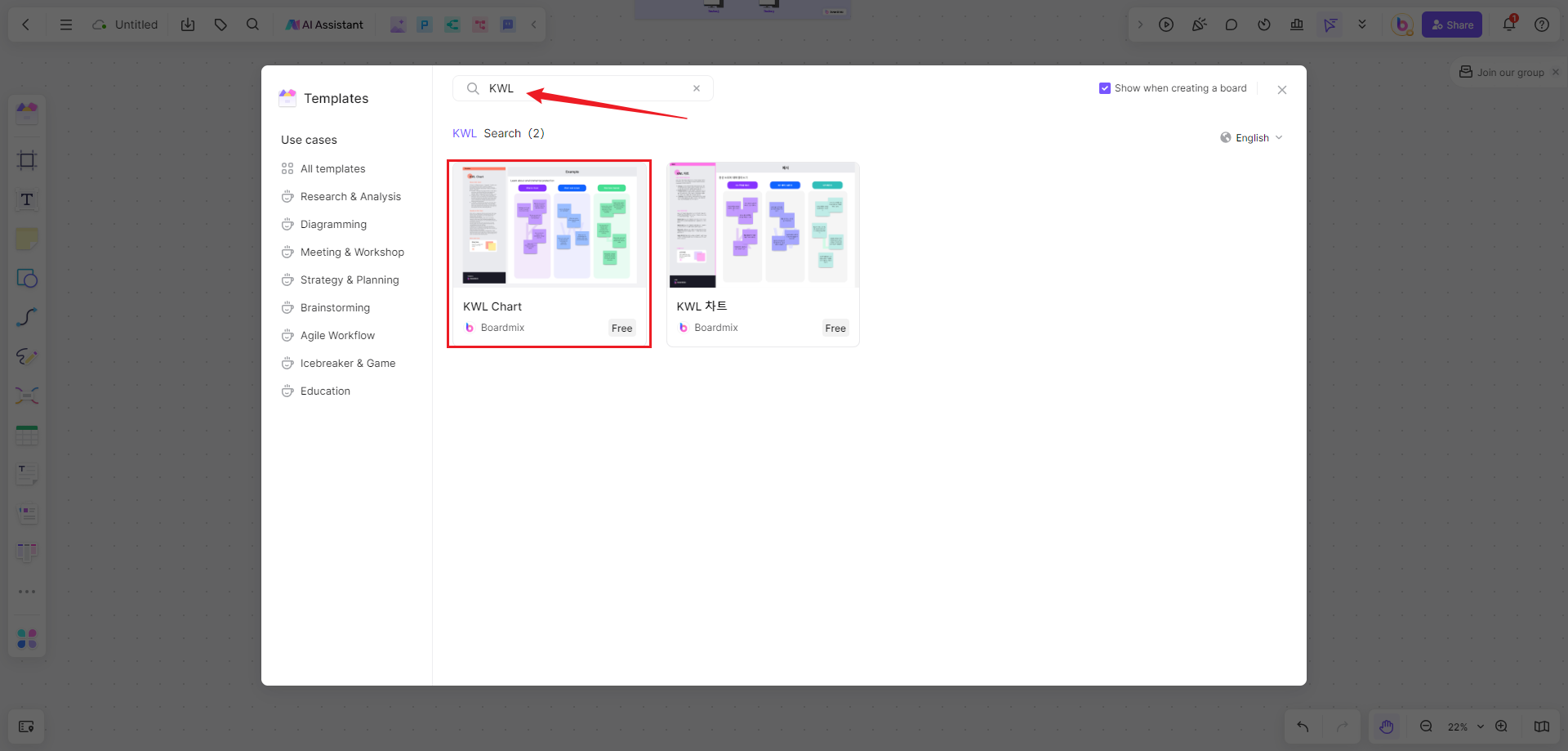
Step 3. You'll be redirected to our interactive whiteboard where you can start customizing your chart.
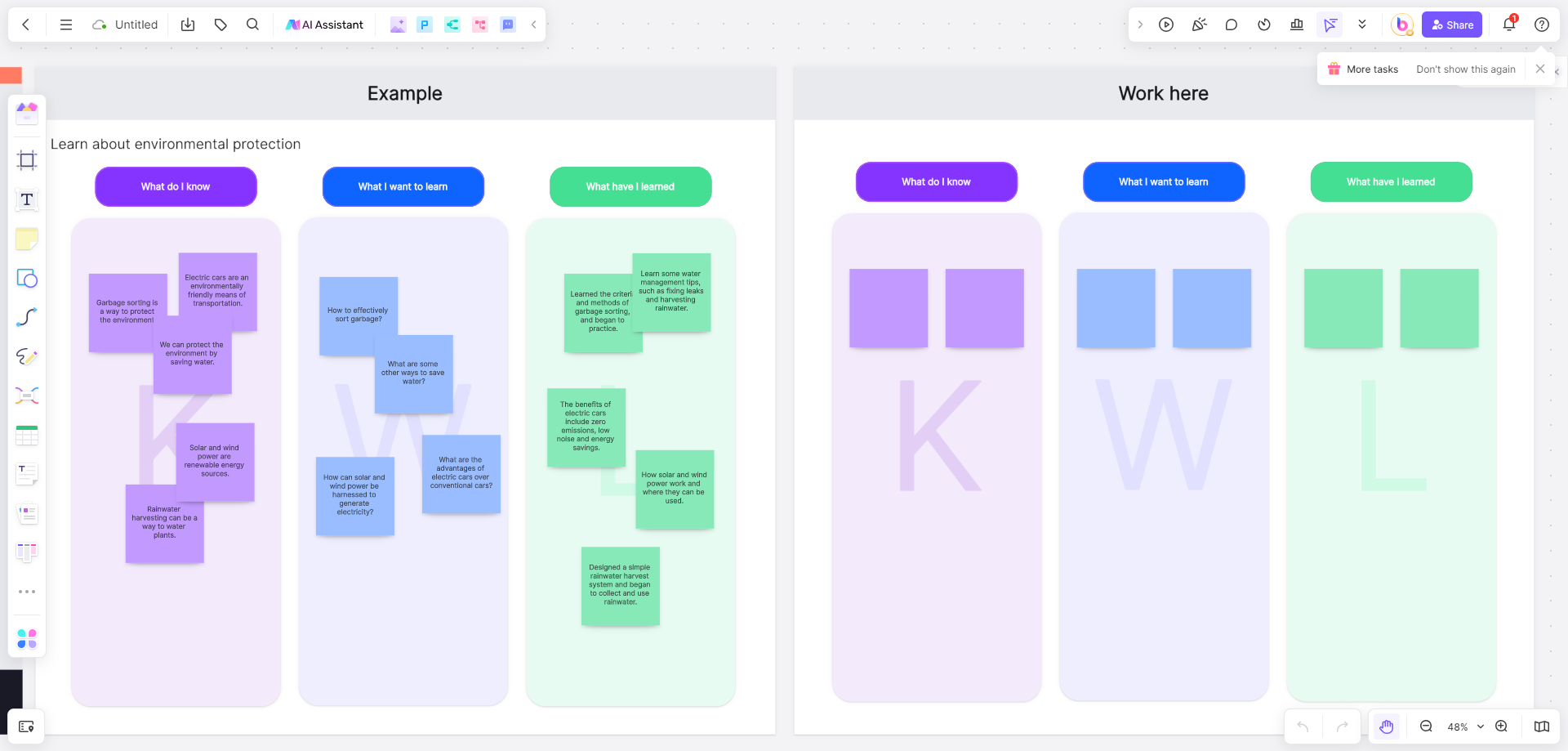
Step 4. Click on each section (Know, Want to know, Learned) to add your text.

Step 5. Use our drawing tools and shapes to further personalize your chart.

Step 6. Once done, save your chart and share it with others via email or a unique link.
Part 6. Variations of the KWL Chart
While the traditional KWL chart (Know, Want to know, Learned) is widely used, educators often adapt or customize it to better suit their specific needs or to add complexity to the learning process. Here are a few variations of the KWL chart:
1. KWHL Chart:
H - How will I learn it? or How will I find out?
This variation adds an additional step to prompt students to consider the methods or resources they will use to acquire the information. It encourages students to think about the process of learning.
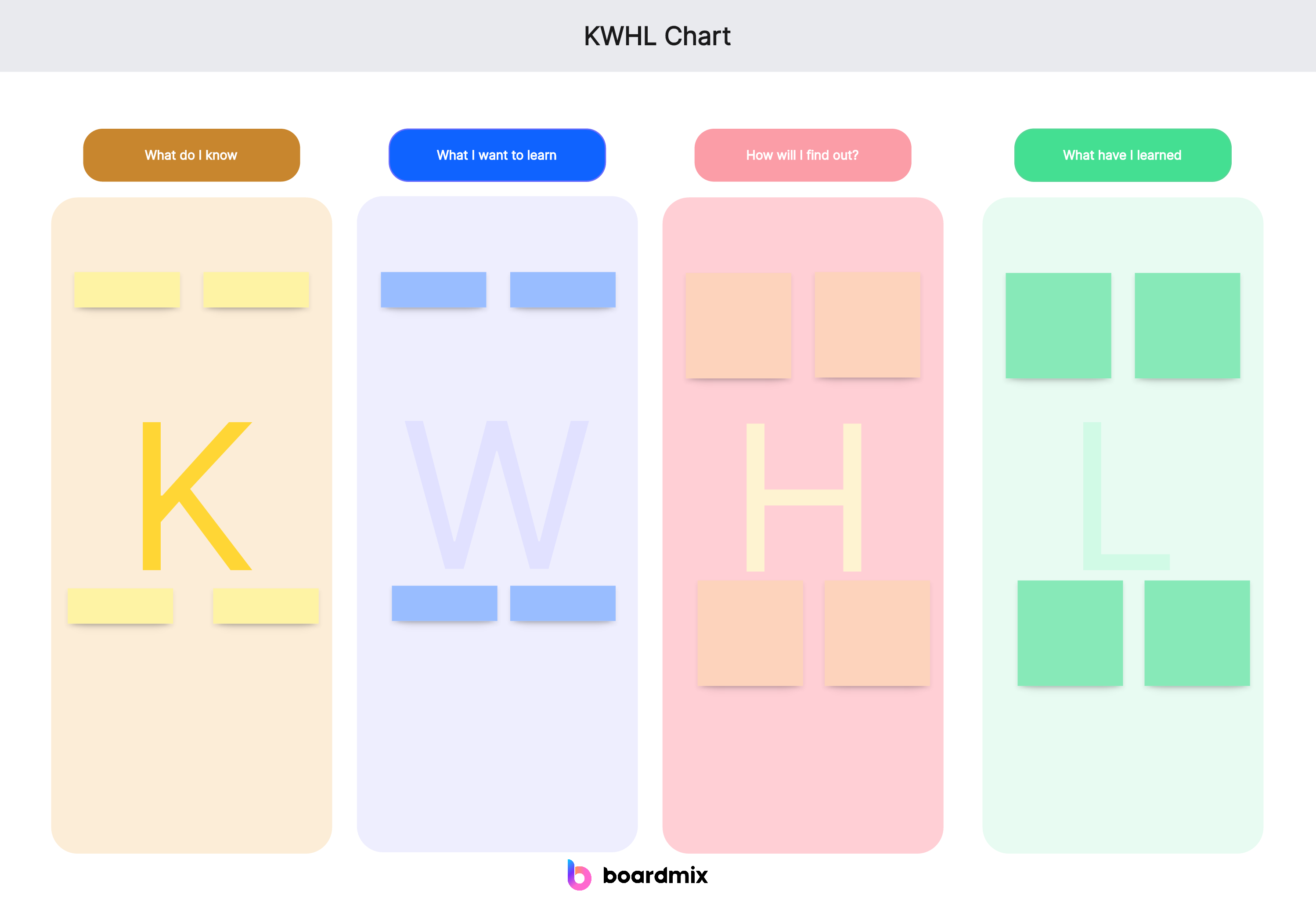
2. KLEWS Chart:
S - What do I still want to know?
This variation replaces "Want to know" with "What do I still want to know?" to emphasize ongoing curiosity and encourage students to continue exploring the topic beyond the initial learning phase.

3. KWPL Chart:
P - What's my plan for learning?
This variation focuses on the planning aspect of learning, asking students to outline their strategies and steps for acquiring knowledge on the given topic.
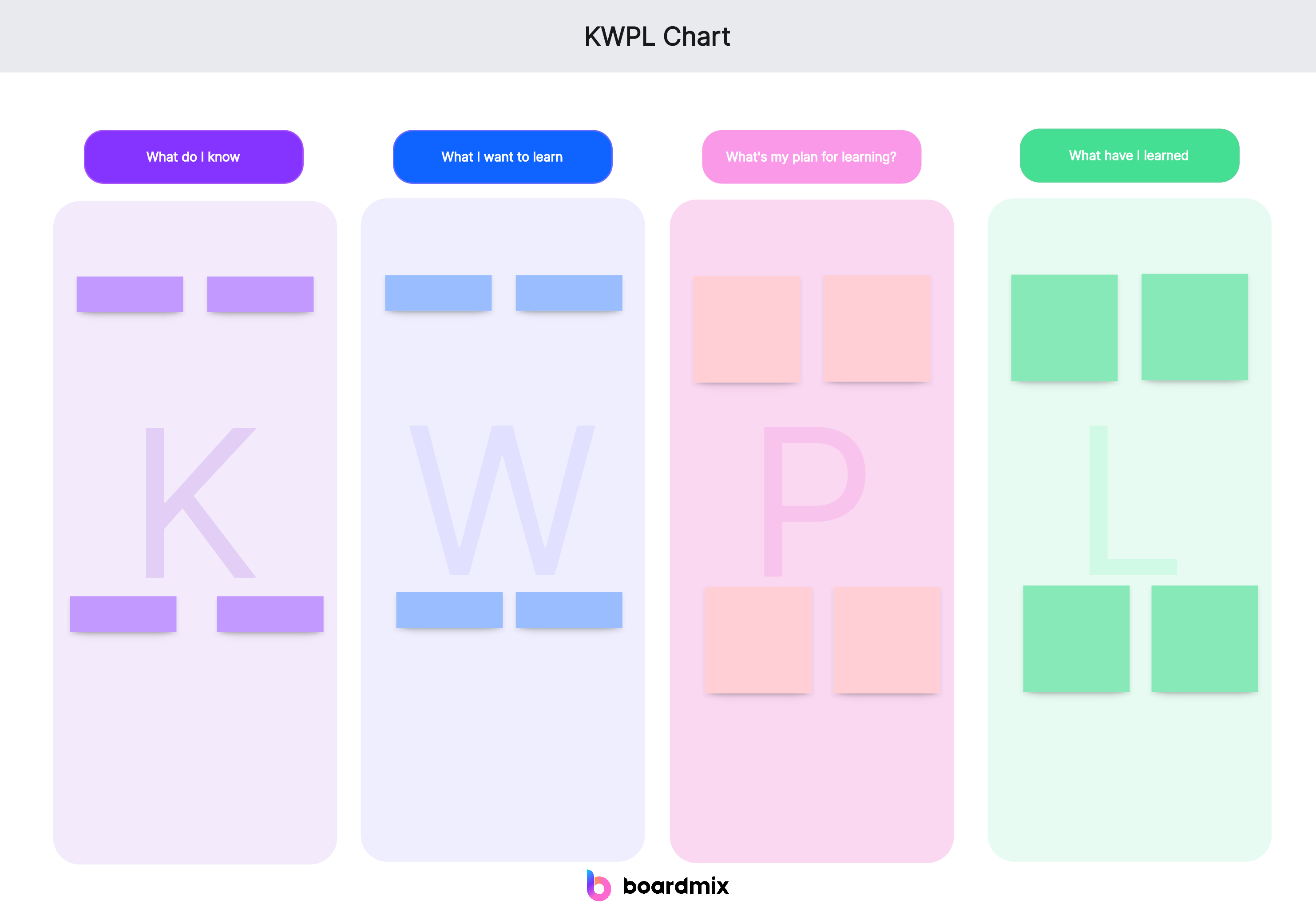
Conclusion
In conclusion, the KWL chart is a powerful and versatile instructional tool that empowers students to take an active role in their learning journey. By leveraging prior knowledge, setting goals, and reflecting on their learning, students can develop a deeper understanding of the subject matter and cultivate essential skills such as critical thinking and metacognition. Integrating KWL charts into instructional practices contributes to a more student-centered and engaging learning environment, ultimately fostering a lifelong love of learning.
Ready to revolutionize the way you create KWL charts? With Boardmix's intuitive interface and pre-designed templates, creating a KWL chart has never been easier. Sign up for free today and start transforming your ideas into visually engaging KWL charts with Boardmix.








